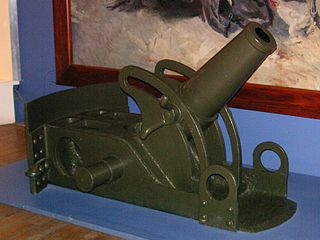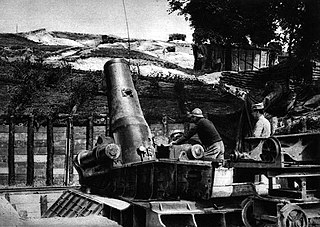
A mortar is usually a simple, lightweight, man-portable, muzzle-loaded weapon, consisting of a smooth-bore metal tube fixed to a base plate with a lightweight bipod mount and a sight. They launch explosive shells in high-arcing ballistic trajectories. Mortars are typically used as indirect fire weapons for close fire support with a variety of ammunition.

The 120-PM-38 or M1938 was a 120 mm Soviet mortar that was used in large numbers by the Red Army during World War II. Although a conventional design its combination of light weight, mobility, heavy firepower and range saw its features widely copied by successive generations of mortars.

The 12 cm Granatwerfer 42 was a mortar used by Germany during World War II.

The Mortier de 280 TR Modèle 1914 Schneider was a French siege howitzer manufactured by the Schneider et Cie company, used during World War I. The howitzer had its origins from a Russian Army policy to upgrade its artillery park after the poor showing of Russian artillery in the 1904-5 Russo-Japanese war. In 1909 an agreement was signed between Schneider and the Russian armaments manufacturer Putilov to jointly develop and produce a number of artillery types. One of these types was a 279.4 mm (11-inch) siege howitzer with a range of 6,000 m (20,000 ft) to replace very old Russian guns of similar calibre. Schneider delivered the first prototype of the siege howitzer to the Russians in 1912 for extensive testing. Although the Russians found the gun was unable to penetrate the heaviest reinforced concrete fortifications its general performance was judged satisfactory which led to an order for 16 howitzers to be delivered in 1915. The French Army expressed interest in the Schneider howitzer as a possible replacement for the Mortier de 370 Mle 1885 De Bange. After some dithering by French authorities 18 howitzers were ordered in 1913. Delivery of the howitzers to Russia and France was delayed by the general mobilisation of 1914 which disrupted industrial production. During the war 126 howitzers were delivered to the French Army and 26 to Russia as the 280 mm Schneider Mortar Model 1914/15 before the 1917 revolutions. In addition another 25 barrels were installed post-WW1 on the Saint-Chamond heavy self-propelled gun chassis as the Mortier 280 mm TR de Schneider sur affût-chenilles St Chamond.

The Brandt 60 mm Long Range gun-mortar is a breech loading mortar capable of firing on a flat trajectory. It was developed from the Brandt Mle CM60A1 and resembles a long-barrelled, long-ranged variant of that weapon.

The MO-120 RT or MO-120-RT is a heavy mortar of French origin. The RT in the designator stands for rayé, tracté, which means rifled, towed. The MO-120-RT is currently used by the French Army, and has also been sold to more than 24 foreign countries or is produced under licence in various countries. The MO-120 RT is issued by artillery units, where it augments the 155 mm artillery, or infantry units in some countries.

The Hotchkiss 25 mm anti-aircraft gun was an anti-aircraft autocannon designed by the French firm of Hotchkiss. It served in World War II with French, Japanese and other nations' forces. Other than the designer company and the calibre, this weapon is not related to the semi-automatic 25 mm Hotchkiss anti-tank gun; in particular, the cartridge used is different.

The Stokes mortar was a British trench mortar designed by Sir Wilfred Stokes KBE that was issued to the British and U.S. armies, as well as the Portuguese Expeditionary Corps, during the later half of the First World War. The 3-inch trench mortar is a smooth-bore, muzzle-loading weapon for high angles of fire. Although it is called a 3-inch mortar, its bore is actually 3.2 inches or 81 mm.

Edgar William Brandt was a French ironworker, prolific weapons designer and head of a company that designed 60mm, 81mm and 120mm mortars that were very widely copied throughout and subsequent to World War II. He also invented discarding-sabot artillery shells, and contributed substantially through his development of HEAT rifle grenades to the development of effective HEAT-warhead weapons for infantry anti-tank use.

The 13.2 mm Hotchkiss machine gun was a heavy machine gun designed and manufactured by Hotchkiss et Cie from the late 1920s until World War II and saw service with various nations' forces, including Italy and Japan where the gun was built under license.

The Mortier de 58 mm type 2, also known as the Crapouillot or "little toad" from its appearance, was the standard French medium trench mortar of World War I.

The Brandt mle 27/31 mortar was a regulation weapon of the French army during the Second World War. Designed by Edgar Brandt, it was a refinement of the Stokes mortar. The Brandt mortar was highly influential, being licensed built or copied by numerous countries.

The Brandt Mle CM60A1, also known as the Brandt HB 60LP, MCB-60 HB, or simply as the Brandt 60mm LP Gun-Mortar, is a 60mm gun-mortar. Unlike conventional infantry mortars, it was not designed to be mounted on a bipod and a baseplate, but rather in the turrets of armoured fighting vehicles. The CM60A1 could be fired at a very low angle of elevation, giving it the dual purpose of direct fire artillery. Its hydraulic recoil mechanism reduces peak loads, allowing it to be mounted in very light armoured cars, such as the Panhard AML-60, or wheeled armoured personnel carriers, like the Panhard M3.

The Mortier 280 mm TR de Schneider sur affût-chenilles St Chamond was a French self-propelled siege howitzer designed during the First World War and used during the Second World War.

The Mortier de 270 mm modèle 1889 sur affût G was a heavy mortar originally employed as coastal artillery and later converted to the siege artillery role. Mle 1889 mortars were used in both the First world war and Second world wars.

The Mortier de 270 mm modèle 1885 was a French heavy mortar employed as siege artillery during the First world war.

The Mortier de 220 mm L modèle 1880 was a French heavy mortar employed as siege artillery during the First world war.

The Mortier de 370 modèle 1914 Filloux (MLE) is a siege mortar. It was designed before the First world war and was used in both the First and Second world wars.



















